Photos: Kip Miller
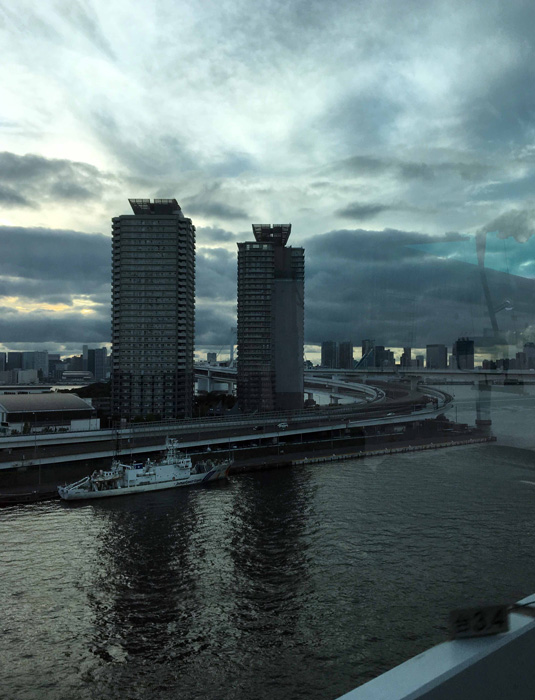
Cloud cover adds drama to Tokyo Bay, an inlet from the Pacific
Ocean spanned by numerous bridges and underwater roads.
It's the end of September, a season marked by typhoons and powerful winds. "We just had a violent storm and power blackouts that affected millions. There was a lot of structural damage, but fortunately no deaths," Jay explains. "Japan is a country that experiences frequent natural disasters," he continues, "from earthquakes and volcanic eruptions to drenching rains and gale force winds." I sit back, grateful that we seem to have caught a window of calm that may last for the duration of our visit. Perhaps, I theorize, the extreme forces of nature here are what have propelled the industrious people of Japan to the highest levels of achievement in art, architecture, science and technology.
"We are at the tail end of the rice season," Jay continues, pointing to a yellowed rice field stripped of its crop. "Unfortunately, Japan is a one-crop nation. Throughout our history rice has been essential and contributions to our samurai lords were measured in kokus of rice. A koku is the amount of rice it takes to feed one man for a year. Unfortunately, we have to import almost everything else, including oil and natural gas." But look at all that Japan manages to export, I muse, thinking about our Japanese cars, computers, cameras and even toilets back home.
"I was born in the countryside," Jay shares his own history. "My ancestors had been farmers for generations. And whenever I have a break between tours, I head back home to do a little yard work. Unfortunately, most young people today have given up farming altogether because there are better opportunities in Tokyo." Accordingly, greater Tokyo, once called Edo, has literally exploded, with a population today that surpasses 38 million. "Staggering!" says my husband. "But how does one survive in that urban landscape?"
The bus zooms past a series of apartment complexes and row after row of balconies strung with laundry. "All our laundry is sun-dried because utilities are very expensive," Jay explains. Soon dramatic Tokyo Bay looms on the left where an underground highway is hidden beneath the water. Jay points to Rainbow Bridge which is lit up at night. Ahead of us Tokyo's dramatic skyline comes into view. It is beyond breathtaking, an endless sea of high-rise office and apartment buildings. Etched amid all the gray is red-glazed Tokyo Tower, rising 984 feet high with an observation deck that provides sweeping views of the city. "It's the Japanese Eiffel Tower," I blurt out. But this landmark that ranked as the city's tallest structure from 1958 to 2012 has just been supplanted by Tokyo Skytree, a tower that touches the clouds at 2,080 feet. "I have to interject that here in Japan we love American culture," Jay adds with a big grin. "We have our own Disneyland and 12 baseball teams. Golf and basketball are hugely popular too. In fact, American pop culture is everywhere and there are now many signs in English." "Thank goodness," I sigh. This is not Europe, after all, and few Americans have an ear for the Japanese language nor a clue about its written characters.
Minutes later the bus pulls in front of the Daiichi Hotel in the Shinbashi area. It is an elegant hostelry known for its impeccable service and only a five-minute walk to the popular Ginza area. While our room is well appointed and comfortable, it is totally eclipsed by a high-tech bathroom featuring a toilet with a brain. It lights up and flushes automatically, providing the ultimate in sanitation. "My goodness, haven't we come a long way," I chuckle, suddenly recalling a primitive toilet experience we had in Konya, Turkey decades earlier.
We have just
met up with our New Haven traveling friends, Kathy and Eric, who arrived
separately via Canada. While all of us are extremely jet-lagged, we are
excited to be experiencing Japan together, a destination that had been
high on everyone's list. Dinner is on our own, and we make a bee line
to a nearby eatery specializing in gyoza and tempura. The food is familiar
fare and fresh and tasty. "Look at how clean everything is,"
I mutter as I survey the premises. But then I had read that Japan has
the highest food sanitation standards in the world. Not only that, one
rarely finds a stray paper or discards on its streets, and anyone who
is ill will usually wear a mask in public, keeping microbes and viruses
at bay. "The Japanese are an amazing people," I remark to Kathy.
"How wonderful to be so considerate of your fellow man and the environment."
"And also notice how polite they are!" Kathy adds.
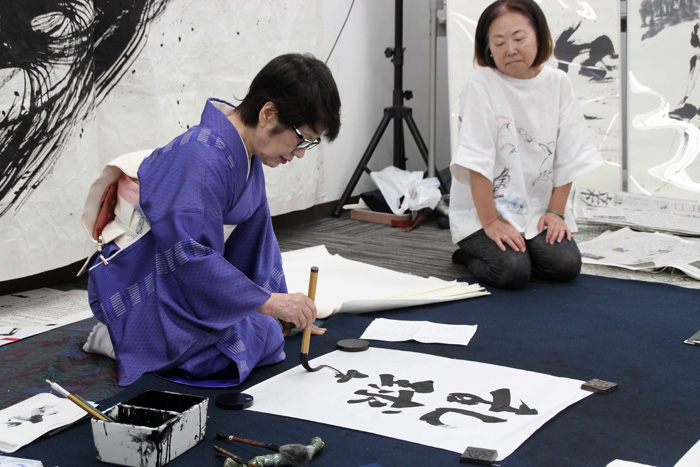
Award-winning calligraphy artist Kuniko-san demonstrates her personal style, a blend of traditional Japanese characters and contemporary logo design.
Just how does one begin a visit to Tokyo? Jay takes our tour group to a calligraphy studio where an award-winning artist, Kuniko-san, demonstrates her craft. "This year she is doing some major projects for the upcoming Olympics," he explains. "Her work is unique because she is skilled in blending traditional calligraphy techniques with contemporary logo design." An English speaking assistant shows off an array of brushes made out of sheep and monkey hair, even peacock and rooster feathers. The suzuri (ink) is derived from pine soot. Kuniko launches a bravura demo of her artistry, a technique called souboku that combines calligraphy and painting, reflecting both restraint and dramatic flourish. Two volunteers from our group are encouraged to try their hand with a brush, ink and a blank sheet of paper to surprisingly charming results. The class has been absolutely fascinating, but I am itching to see the city.
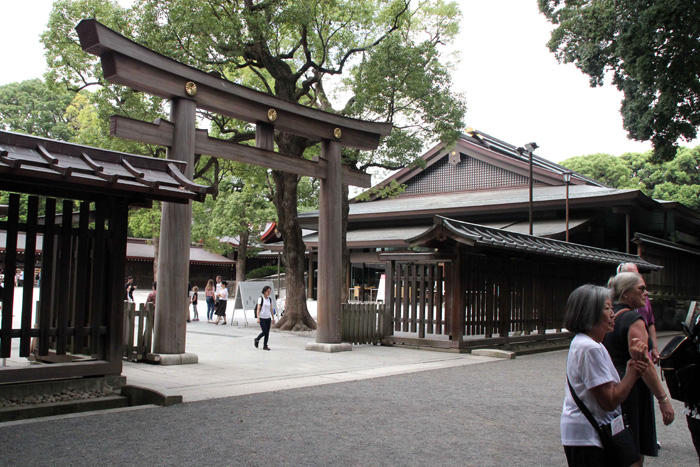
The Meiji Shrine, tucked into a magnificent park with over 100,000 trees, is dedicated to the country's first Emperor, Meiji, and his wife, Shoken, who united the country after centuries of Shogun control.
With barely a cloud in the Tokyo sky, it's an ideal day to visit the Meiji
Shrine, the city's number one attraction, tucked into a forest of over
100,000 trees donated by families all over the country. The park is dedicated
to Japan's first Emperor Meiji and Empress Shoken who united the country
after centuries of Shogun control. A winding path takes us to an inner
garden planted with rhododendrons, azaleas and camellias, reflecting Japan's
reputation as a country that values harmony with nature. We wind through
the park to the edge of an enormous shrine complex devoted to Japan's
ancient Shinto religion. "Shinto is a way of life," Jay notes.
"People visit this shrine to commemorate birth, a special birthday,
coming of age, marriage and death." Apparently, when Buddhism arrived
in Japan in the 6th century, it blended effortlessly with Shintoism. "Today
nearly 80% of our people are both Shinto and Buddhist," he reveals.
Simply put,
the Shinto religion is just a way of life. "It enshrines the divine
with its nature worship, but makes few demands on its followers,"
Jay clarifies as he leads us to a well with special cups to scoop up water
to rinse our hands before we enter the shrine. To the right, a huge camphor
tree towers over hundreds of votive offerings (ema) hung beneath. "Before
entering the shrine, one must perform a little ritual," Jay explains
as he bows twice, claps twice and ends with a deep single bow. We follow
his example and ascend the staircase to the beautiful cypress shrine which
is packed with worshipers. On a communal wish wall, their supplications
are hung in neat rows. The scent of incense imbues the shrine with an
air of mystery and possibility. We return to the front court to admire
an extended family that has gathered to celebrate their three-year old's
third birthday. She is dressed in a vibrant kimono and could not be more
adorable.
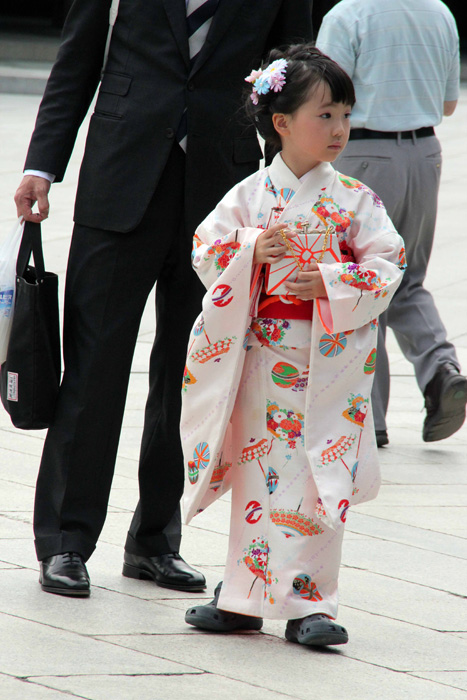
A Japanese family gathers at the Meiji Shrine to commemorate their three-year-old daughter's birthday.
The greenery is well behind us as the bus cruises on Onomotesando, Tokyo's glitziest shopping street, lined with opulent, architect-designed buildings, many the brainchild of Pritzker Prize recipients. Japanese maples, their leaves tinged with autumn yellow, soften the sleek, angled geometry of the structures. "This is our Champs Élysées," says Jay, pointing toward the elegant emporiums of Dior, Prada and Gucci. Interspersed among them are several Michelin-starred restaurants popular with corporate heads and international glitterati. "The Hayajuko area just beyond here is packed with hip cafes that are popular with thousands of teens wearing the latest fashions," he adds. Minutes later, we arrive at The Ginza, the city's famous upmarket shopping area, especially known for its department stores, international restaurants and high tech night clubs.
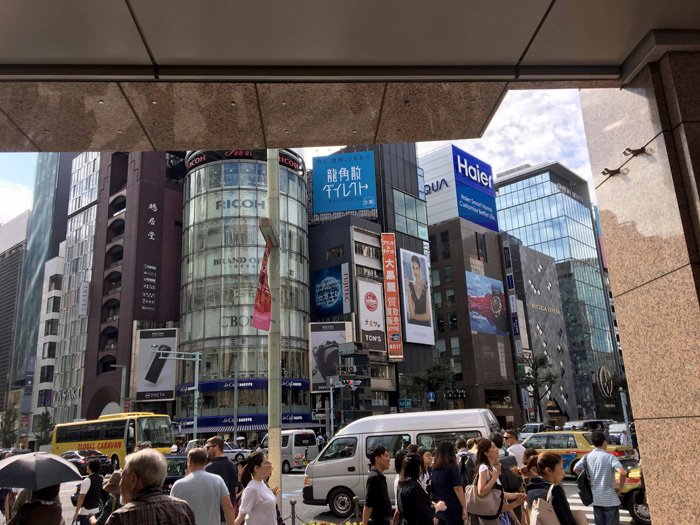
The Ginza area has garnered a stellar reputation for its high-end department stores, night clubs and restaurants that attract an international audience.
Experiencing Mitsokushi, Tokyo's most elegant department store, is something
one has to do on foot. "Visit the lower floors first," says
Jay. "Here you will find an enormous food court with both Japanese
and international dishes that are ready to eat. You can take the escalator
up to the very top with your food selections and grab a table on the rooftop.
It's a delightful place to have lunch," he insists. The food court
is enormous. We survey a cornucopia of salads, entrees and desserts artfully
displayed behind glass. "Oh, what to eat first," says Eric,
ogling an array of Japanese seafood salads. "Do you think we bought
too much?" asks Kathy as we take the escalator, sneaking glances
at each floor's inventory on the ascent. A minute later, Jay arrives,
bringing his own lunch to our table. "We're actually eating out of
high-end bento boxes," I remark, admiring all our overflowing containers.
It's a balmy
evening and just a short walk through streets filled with bars and tiny
eateries to our designated group dinner site. We pass by a long line of
corporate youths, all impeccably dressed in dark suits, patiently waiting
to enter a popular sushi palace with a reputation for rarified fresh fare.
At a traditional Japanese restaurant, our table is at floor level with
cutouts for inserting our legs. A printed menu explains the lineup of
courses. From fried Spanish mackerel and shrimp skewers to beef simmered
in sesame dressing and a warm broth with turnips and mushrooms, it's a
huge spread. Jay surprises me with a birthday cake, a gesture of kindness
that typifies Odysseys Unlimited's attention to detail. Beyond sated,
we all search for our shoes left behind in a line outside the dining room,
a ritual to be repeated throughout our trip.
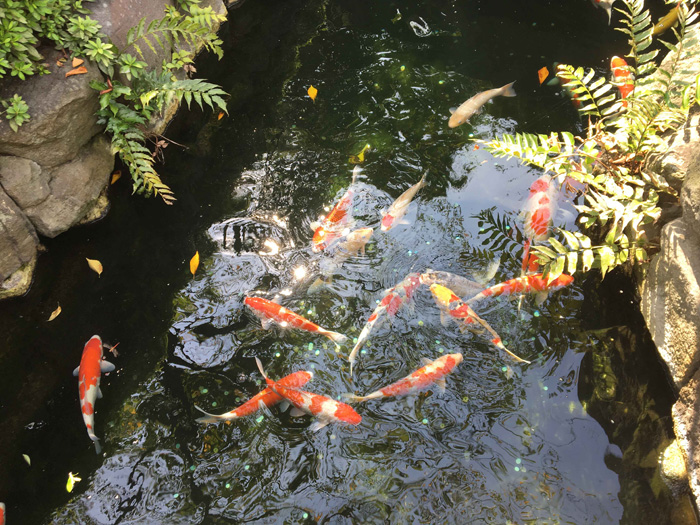
Colorful koi splash in a rushing stream in the outer gardens of Japan's Imperial Palace, home to the Emperor and his family.
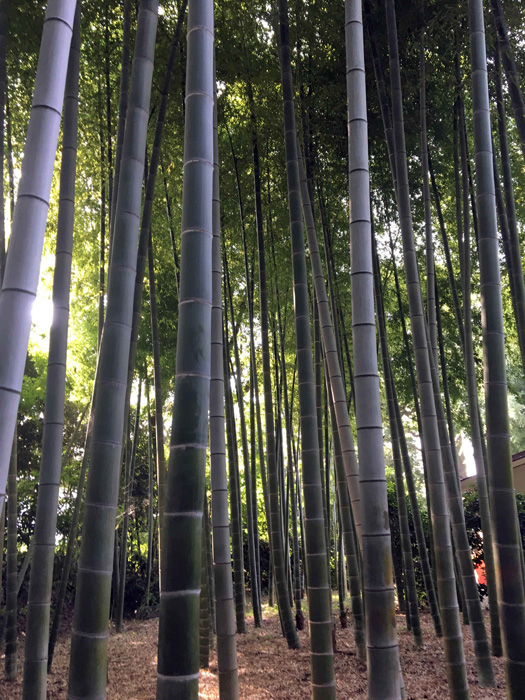
Interspersed amid Japan's famed cherry trees are stately
pines, sycamores, oaks, and even a mini forest of bamboo.
"Ohio godaimus (good morning)," I mumble as I ascend our bus for our second touring day in Tokyo. "Ohio, Dalia-san," replies Jay with a bright smile. Although it's muggy this morning, the rain promises hold off. We head out to visit the outer gardens of Japan's Imperial Palace, home to 83-year-old Emperor Akhito who has just stepped down in favor of his son, Isahito, grandson of the notorious Hirohito, one of World War II's villains. The Imperial throne of Japan has been in the hands of this royal family for over 150 years and the palace occupies a 300-acre site surrounded by granite block walls. "The palace and grounds are maintained by a staff of 1,000," says Jay, pointing to a group of grounds workers who have gathered for a staff meeting nearby. The East Park is manicured to perfection and studded with majestic sycamores, pines, oaks and a mini forest of bamboo. A beautiful pond is alive with colorful koi and an arbor is draped with wisteria. "Of course, the cherry tree blossoms in the park are extra special," brags Jay, making me wish that we had come to Japan in springtime. "This place sure merits a prolonged visit," says my husband.
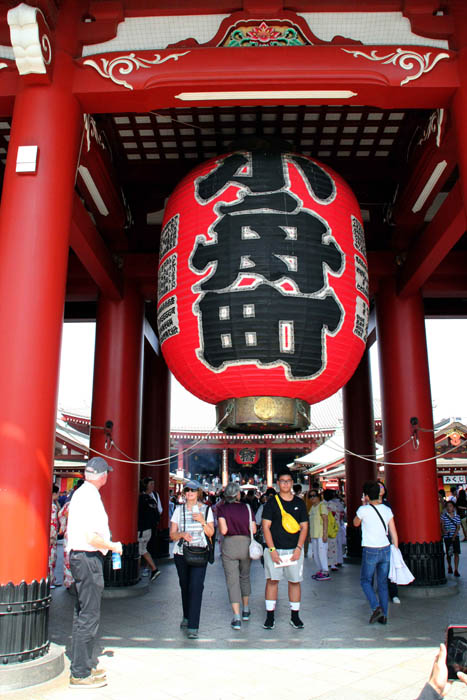
Built in 645, Sensoji Temple's signature gateway is crisscrossed by
thousands of visitors daily, a melting pot of tourists and local residents.
But we have a full itinerary and continue on to the Sensoji Temple in the lively Asakusa area of Tokyo. It is the city's oldest and most important temple, dating from the 7th century. "According to legend," explains Jay, "two fishermen pulled a statue of the goddess of mercy, Kannon, out of the Sumida River nearby. Although they returned her to the river, she kept reemerging. So in her honor, a temple was built in 645." Today it is one of Tokyo's treasures. I survey the site to find it absolutely throbbing with both local and international visitors. The outer gate, Kaminarmon or Thunder Gate, has become the symbol of the surrounding Asakusa neighborhood. We wander inside and watch people toss coins through the grates of a wooden box, followed by the now familiar ritual of bows and claps. "Shinto followers are superstitious," Jay explains pointing to stalls selling various votives. "Whenever they receive a bad fortune on paper, they tie it onto a wood stick to get rid of it." We head out on our own to Asakusa's colorful shopping street, chock full of assorted eateries, and stalls brimming with votives, incense, and souvenirs. At Askakusa-Shijou, a modern two-story restaurant, a tableside computer screen provides visuals of the menu. The sashimi set meal is a bargain at 1260 yen. Steamed edemame and salads, plus their house beers complete our tasty lunch. How fortuitous for us that Japanese menus compensate for their difficult language by providing either photos or lifelike plastic facsimiles of each dish!
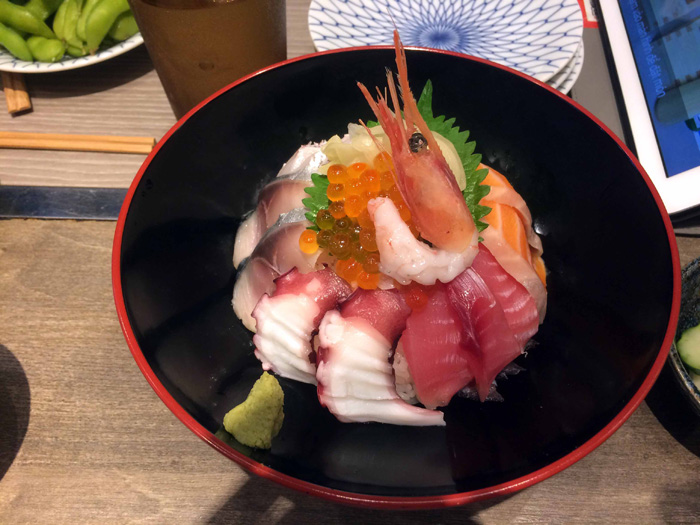
A bowl of fresh sashimi is artfully presented at Asakusa-Shijou, a neighborhood restaurant just a short stroll from Sensoji Temple.
Tokyo's National Museum in Ueno Park is the oldest museum in Japan and one of the largest in the entire world. "Not long ago the museum had an exhibition on Katsushika Hokusai," says Jay. "He is regarded as Japan's greatest woodblock artist from the Edo Period. "In March of this year, one his prints sold for a record $471,000 at auction. Hokusai's work memorializes the coast of Kanagawa, not far from Mount Fuji which we will be visiting tomorrow, and views of the mountain are incorporated into many of his prints." The museum is so massive that we only have time to tour a couple of floors. Spanning thousands of years from the Paleolithic Era to the present, it highlights vessels and figurines from 3000-2000 BC, magnificent sculptures and courtly art from the Buddhist period, Zen and ink paintings from the Shogun Era and representations of the Tea Ceremony. I am especially taken by the attire of the military elite, the samurai warriors of the Heian period whose feudal lords established a military style of government known as the shogunate. "Each lord's army had a different style of armor," observes my husband as he photographs an especially outstanding example. We continue to roomfuls of screens and sliding door paintings, lingering in front of masks from the kabuki theater and kimono style robes with colorful woven designs. "The fashions of the Edo period are especially elegant," I comment, zooming through the rest of the exhibit, the humidity of the day having exacted its toll on me. "Tomorrow we will be traveling to Hakone and staying in a ryokan," announces Jay back on the bus, setting the stage for our next adventure.

Samurai soldiers were the army of powerful warlords that controlled
Japan for centuries. Each lord's soldiers wore distinctive suits of armor.
In early morning the bus heads west of out Tokyo on a wide avenue lined
with beautifully pruned ginko trees. Jay points out the new Tokyo Olympics
Stadium being readied for summer 2020 at a cost of $1.8 billion. We gaze
at the Shinjuku portion of the city, a densely concentrated area resembling
Manhattan and filled with government and service buildings. The tall structures
bring back memories of a recent earthquake for Jay. "My wife was
on the 52nd floor of a building when the 9.0 earthquake struck. That's
the same quake that generated the 50-foot tsunami that killed 20,000 people
on the island of Hokkaido and shut down the Fukushima nuclear plant."
Hearing the statistics, I am astounded by the resilience of the Japanese
people, who always pick up the pieces and move on. "At this time
we have 140 bus and train lines in greater Tokyo," Jay remarks as
we head out of town. That infrastructure will be surely be a boon next
summer at the Olympics when 10 million foreign visitors descend on Tokyo,
I decide.
"Japan
is 70% mountains," Jay gestures toward a marker for Kanagawa Province,
a magnificent forested area carpeted with cypresses, cedars and other
evergreens. We speed past several small towns. For the first time I can
actually spot clusters of individual homes, undoubtedly made possible
by the lower price of land in these parts. "Tomorrow you will have
a chance to ride on a bullet train headed toward Tanagawa, Jay notes.
"But Japan has something else in the planning now, a new experimental
railway called MAGLIFT that uses magnetic levitation at a speed of 300
miles per hour. It's a work in progress and won't be operational for another
20 years." "Wow," exclaims Eric from across the aisle.
"The Japanese have everything figured out!"
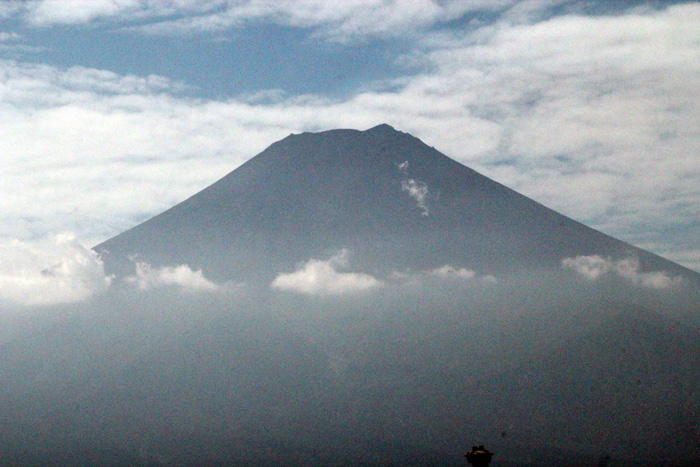
Snow-clad Mount Fuji rises more than 12,000 feet and is hidden by clouds for most of the year. But in early autumn the snow is gone and the mountain reveals itself.
Mount Fuji or Fuji-san is a dormant volcano that last erupted 300 years
ago. It is perfectly conical in shape and surrounded by five lakes. This
magical landscape has a spiritual quality, one that was augmented by millions
of red cedar trees planted after World War II. Fuji's mysticism is revered
by Japanese and foreign visitors alike. Situated in Fuji Hakone National
Park, it is snow-covered and shrouded in clouds for much of the year,
but today it is naked and visible, its cloud cover having lifted for a
short spell. A popular children's song about the mountain lists its virtues,
namely that "above the clouds, you can even hear the lightening."
On its lower slopes, Fuji is carpeted with beech and maple trees, already
turning yellow in the cool autumn air. When one ascends the mountain during
much of the year, its snow cover can be quite substantial. Climbers often
encounter boars, foxes, deer and even bears. "The deer and bear population
is exploding," says Jay, "and this can sometimes be a problem
for hikers." The bus approaches the Fifth Station, a parking and
concession area that is teeming with visitors. Here we will have a chance
to take panoramic photos of the mountain and the surrounding valley and
browse through stores packed with all sorts of souvenirs and snacks, not
to mention Mount Fuji hoodies that make perfect gifts.
The bus heads south toward Hakone and Lake Ashi where we are scheduled to take a relaxing boat ride through the mountainous terrain. The entire region is volcanic, with many hot springs gurgling under the surface. It is the ideal place for a ryokan stay and a chance to experience traditional Japanese bathing in the nude in the springs that are part of many ryokan establishments. "Volcanic activity in this region began about 400,000 years ago," Jay elaborates. "People have been coming here to relax for generations, especially those who live in crowded cities." The bus makes one more bend and Lake Ashi comes into view, a crater lake at the base of a volcanic caldera some 723 meters above sea level. Here the town of Hakone Machi was first established in 1603 as a military checkpoint for protecting Edo (Tokyo). It's a beautiful day, and as the boat makes a few bends, we catch occasional glimpses of Mount Fuji in the distance and close-ups of two small villages. "At this site every January 2nd, Hakone University conducts traditional relay races that attract large crowds," Jay notes.
Mesmerized by the magical setting, we head back toward Hakone town and Aura Tachibana, an elegant ryokan where one can experience a traditional Japanese hotel stay. Our room is outfitted with tatami mats and a low table for dining. Guests sit on the floor and sleep atop thin futons set up by attendants. An alcove has two chairs and a small table, a gratifying spot for seniors who have a hard time descending to the floor. The closet is hung with two yukatas, traditional Japanese robes that we will be wearing at tonight's kaiseki banquet, a lavish multi-course meal that is considered the apotheosis of Japanese cuisine. We wander toward the public bathing areas, deciding ultimately that we prefer bathing in the privacy of our own bathroom.
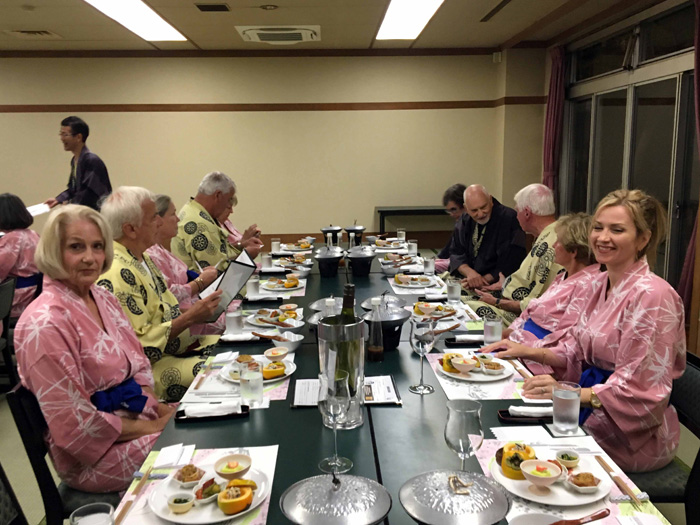
A kaiseki banquet is a multi-course feast that is considered the apotheosis of Japanese cuisine. Our group is about to experience the chef's "omakase," his personally selected and prepared dishes.
Wearing flip flops and yukatas, our entire group has gathered in a private
dining room where our traditional feast is about to commence. The meal
is no small feat and it entails hours of planning, preparation and artful
presentation. "There are about 100 ryokan establishments in Hakone,"
Jay notes. "Ours is very special and the chefs here have gone all
out to make this a feast to remember." Kaiseki is the embodiment
of "omotenashi," or wholehearted hospitality, and "omakase,"
allowing the chef make the food selections. The dinner's beautifully plated
dishes reflect the entire range of Japanese cooking techniques, not to
mention special ingredients. "This meal is a food stylist's ultimate
challenge," I comment, thinking about a dear friend who is considered
one of the finest food stylists on the West Coast. Our appetizers include
seasonal tofu, a persimmon pot, a chrysanthemum garland with soy sauce
and fried sweet potato morsels. Next comes a clear soup and a seafood
salad with five kinds of sashimi and a steamed fish cakes. This is followed
by a grilled beef and luscious scallops steamed in a hot pot. The last
dish includes locally harvested rice and red miso soup with assorted pickled
vegetables. Desserts are a nod to western tastes and feature pumpkin pudding,
Mont Blanc, cheesecake and seasonal fruit. We are all on culinary overload
as we stumble back to our rooms where our futons are in place on the floor.
Descending to the futon and rising from it, let alone sleeping on it,
are doable but a bit challenging. "I am glad it's only one night,"
I murmur to my husband who is already fast asleep under his blanket.
Not being a good sleeper, I ruminate about Japan's amazing aesthetic sensibility that seems to touch every activity in the country. From its manicured gardens and the art of paper folding (origami) to its exemplary calligraphy, lacquer work and ceramics, Japanese artisans manage to find beauty in the ordinary and have become masters in exporting their handiwork, even popular culture such as anime and manga. This is all good, I muse, excited that we will be traveling to small towns during the next few days where we can experience Japan up close and personal.
